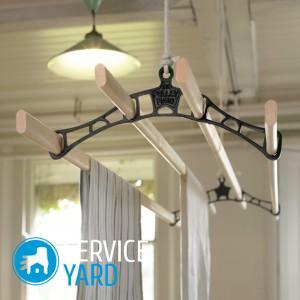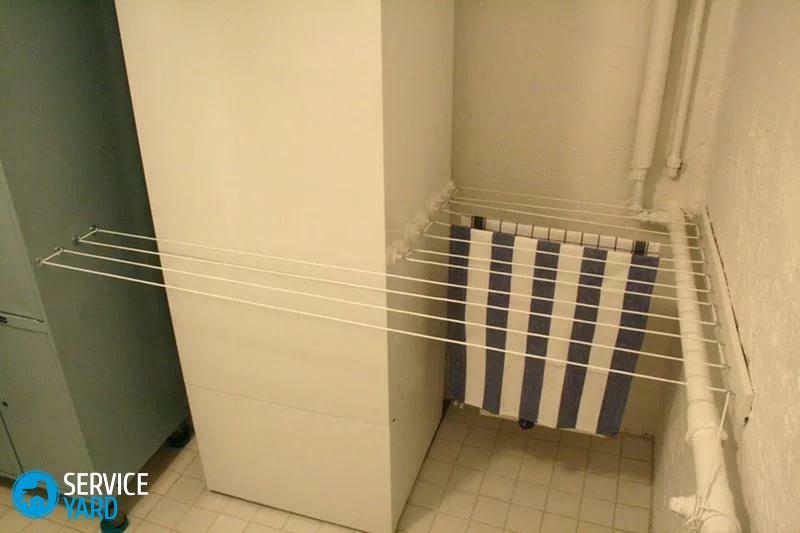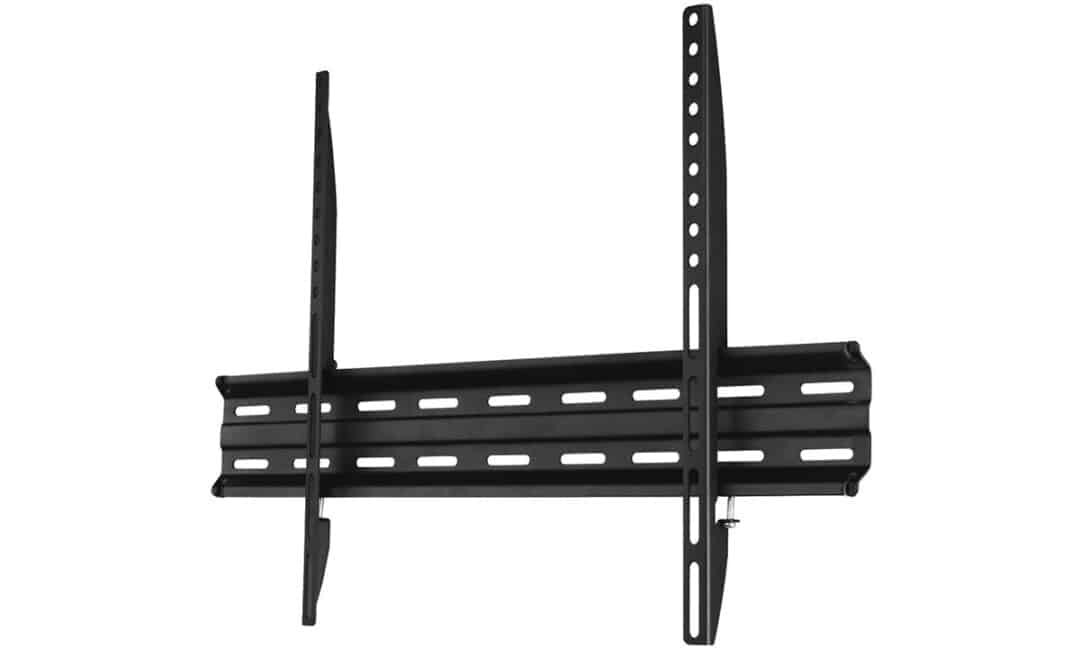
- Drying options
- Where to dry linen?
- What kind of dryers are there: types and principles of operation
- How to choose?
- Other selection criteria
- Dryer by your own hands
If you live in an apartment, you are surely faced with the question: how to dry clothes and what dryer to choose? Especially the problem is urgent at the initial stage of the arrangement of everyday life. The most practical and popular option is a dryer attached to the ceiling. To find out how a laundry dryer is made by yourself, we recommend you read this article.
to the table of contents ↑Drying options
The way of clothes drying in yards and on the adjacent territories has long been outdated. The high-rise buildings are growing higher, the grounds are shrinking in size, often turning into parking lots, and this is simply uncomfortable.
Also as a minus here can be called:
- High risk of repeated contamination of laundry;
- Probability of damage to clothing.
We can only hope for the square meter of our housing. But what if the area of the apartment does not allow drying clothes without compromising on comfort and comfort? The output is simple: build a ceiling dryer for laundry on the balcony with your own hands.
to the contents ↑Where to dry clothes?
As we have already noted, there are several options for the location of dryers.
Balcony
The most popular and convenient place for drying clothes is the balcony.
Things in this case dry quickly, since there is good air circulation. In addition, the balcony is very helpful, when there is simply no space in the apartment where you could put the dryer.
Important! Clothes dried on the balcony are always fresh, which is also a significant advantage.
Bathroom
Another common place for drying is a bathroom.
If your apartment is located on the ground floor or for some other reason is not equipped with a loggia or balcony, you will have to dry things in the bathroom.
Dryers that can be attached to the wall can help, and they do not take up much space. Let's talk about the types of dryers below.
Important! The main disadvantage of this drying is the increased humidity in the bathroom. This feature increases the drying time of clothes. As a result, the latter in the process can acquire an unpleasant odor.
Corridor
As a place for drying clothes, we will not throw off the corridor.
Not the most convenient option. However, there are apartments without a balcony with a small bathroom. In such cases, the hall becomes a real "wand-zaschalochkoy."
Here you can use an outdoor mobile dryer, which can be easily folded and retracted if not needed.
Despite the fact that the choice of design for drying clothes is now very large, interest in how to make a dryer for your own clothes, not only does not fade, but also grows.
This is explained by the simplicity of the manufacturing process: it is possible to build a dryer according to your taste and needs even without experience. It is enough to have the desire and the materials necessary for this.
to the contents ↑What types of dryers are available: types and principles of operation
Dryers are classified as follows.
By the method and installation location:
- Ceiling;
- Wall Mounted;
- Floor.
On the fixing option:
- Mobile;
- Stationary.
By construction type:
- Retractable;
- Folding;
- Suspended.
How to choose?
How does one choose the right dryer from the whole variety of options? Let us consider them in more detail.
Ceiling dryers
Ceiling dryers can be safely called the most practical and convenient option. There are many reasons for this:
- Significant saving of space;
- Invisibility: you can see them only by lifting your head;
- Remote location of drying things that do not interfere with movement.
There are three types of drying for the ceiling.
Capital
Represents the usual version of the dryer, consisting of ropes. It is attached to two parallel blocks located at the top. Such a ceiling dryer for clothes on the balcony with their own hands is quite easy to make. The main job here is to install the fixtures.
Important! When buying drying, evaluate to which surface it will be attached. This will help to choose reliable fastening blocks.
Retractable
The design is very similar to the accordion, which becomes so, if you pull it at the bottom. So it looks in a decomposed form, ready for use. Drying is also fixed to the ceiling.
Important! This option loses in the first order, which holds a smaller number of laundry items.
Dryer-liana
Complicated, and at the same time, the most ergonomic system. It is supported by two fasteners, between which ropes are tightened. The latter with one of the sides stretch to the very corner of the wall.
This option is convenient in that each lath is manageable, regardless of the whole design. Despite the fact that the dryer-liana does not always look aesthetically pleasing, tenants of high-rise buildings are increasingly giving preference to it.
Important! If you are buying an already prepared dryer, pay attention to the mounts that come with the kit. There are designs that are not completed with fixing blocks. In this case, you should consult the seller, which hooks are more suitable for the selected model.
If you decide to make a dryer for your own hands, consider the ceiling finish of the loggia. Sandwich panels and vinyl siding require plastic pads. They must be purchased in advance.
Wall drying
Such systems are divided into two types.
Fixed or capital
Looks almost the same as the same-name ceiling drier, the only difference is in the location of the fasteners. In this case, the hooks are fixed to the walls. The option is considered reliable and simple.
Important! Suitable for small balconies. The height of the cables during operation can not be adjusted, but such a dryer wins the capacity for the next category of wall structures.
Foldable
This variant does not withstand heavy and oversized things. The undoubted advantage is the saving of space. Drying is only two parts with cables that easily hide inside the structure. Easy to use, folds and unfolds with one hand movement.
Floor standing dryers
Here everything is simple. Such a construction does not require fasteners. It can be put and carried anywhere. In case of need, drying is added, freeing up valuable space.
Important! Floor versions accommodate a large amount of laundry. Equipped with additional wings on the sides. This allows you to dry even more clothes. However, in fully decomposed form such a dryer takes not less than 1.5 square meters.m of the apartment area, which is its main disadvantage.
to the table of contents ↑Other selection criteria
The first thing you should look at when buying a drying structure is the area of your apartment. Think about where your dryer will be located.
If there is a balcony, we recommend that you pay attention to the options with a ceiling mount. They are the most convenient, practical and roomy.
How to make your own clothes dryer for clothes on the street - in detail we will tell below.
In the meantime, let us pay attention to another important factor in the choice of drying - the materials from which it is made. 
Materials: what to give preference?
The list of basic materials from which the drying structures are made looks as follows:
- Plastic;
- Stainless steel;
- Aluminum;
- Tree.
What is the difference:
- Plastic drying is easy, but this design does not last long. Variants from plastic are short-lived, but also are much cheaper than others.
- Stainless steel dryers can be called the most durable and reliable. Thanks to the coating of chrome, they look exquisitely in the interior. Such designs do not bend even under the heavy weight of wet clothing.
Important! If you choose quality and durability when choosing, stainless steel designs are your option.
- Dryers made of aluminum are relatively sturdy and lightly resemble plastic. The main disadvantage here is the oxidation of metal in the process of operation. Over time, rust appears on the rods, which can spoil your clothes.
- Wooden drying also takes place. They look very nice and cozy. Variants of wood are not subject to deformation. On these dryers, you can safely place the heaviest things: large sets of bed linen, towels, outerwear.
Important! If you decide to make such a dryer for your own hands, you need to take care of the fasteners. They must be particularly strong.
To dry the wood has served you for a long time, it is necessary to treat it with a special solution from pests and excessive humidity. Then coat the structure with lacquer. This will extend its service life and increase its strength.
to the contents ↑Drying by our own hands
Let's consider a few simple drying structures that can be easily built by yourself.
If you are wondering how to make your own clothes dryer on the street, pay attention to this inexpensive and compact version:
Rope folding dryer
For its manufacture you will need:
- rope;
- quality scissors;
- drill;
- drill bit 16 mm;
- two round wooden sticks, 4 cm in diameter and about 70 cm long;
- 5-meter rope for clothes;
- clamps.
Instruction:
- Take the wooden blocks and make notes, where holes for ropes will be drilled. The distance between them should be about 10 cm.
- Use a drill to make holes in both blanks.
- Pull the rope through the first hole in the wooden workpiece and secure it with the knot. Then - through the last, also having fixed a knot. This will help ease the pressure on the rope when operating the dryer.
- Thread the laundry rope through the remaining holes in the workpieces and also tie the knots.
- Use a twine to fix the structure on the balcony or tree, if you were faced with the task of making a clothes dryer on the street with your own hands.
- The ends of the bars should be tied with a rope in the form of a triangle.
Important! In order to avoid distortion, triangles on both sides should be approximately the same.
Well, now you can admire the result. The advantage of this dryer is its ease of use. It is easily twisted and does not take up any storage space.
Wall-mounted dryer with clothesline ropes
If you are interested in how to make a clothes dryer on the balcony with your own hands, this option will interest in its reliability and roominess.
You will need:
- Fasteners;
- Rings of self-tapping screws;
- Bar;
- Furniture Corner;
- Rope;
- Drill;
- Rings for ropes.
Instruction:
- The manufacturing process should begin with the installation of the fastener.
- We install a furniture corner on the wall.
Important! Pay attention to the dimensions of the furniture corner. It should be large enough to go through the embedded part of the board and the panel.
- Attach the timber to the corner.
- Screw the self-tapping screws into the beams at the same intervals.
- The same rings should be placed on the top of the beam and on the wall where the corner is located.
- On the opposite side, arrange the rope rings.
Important! Thanks to self-tapping rings, in the process of using the dryer it is possible to regulate the degree of tension of the clothesline.
As you have noticed, such a reliable and practical dryer for your own clothes can be made without much effort and knowledge.
Ceiling rope dryer: do it yourself
Is a popular and easy-to-carry option.
For the construction you need:
- Screws with rings on the back of the fasteners - 2 per rope;
- Drill;
- Clothesline;
- Bonding material.
Instruction:
- Drill holes in the walls for screws.
Important! The last in diameter should be more holes in the wall. Only in this way can the structure hold securely.
- Fill all the holes with the bonding material.
- Screw in the screws with your hands.
- Pull the rope through the rings, securing it from both sides.
Important! We advise you to stretch the rope in a staggered manner, without cutting into individual pieces. This will extend the life of the dryer.
Wall-drying fan
If you are thinking how to make a clothes dryer on the balcony with your own hands, but you want the originality, this option is for you.
You will need:
- Nuts and screws;
- Metal Corner;
- Sandpaper;
- Varnish or paint;
- Board;
- Stair balusters.
Important! Choose smooth balusters, as they will perform the function of clothing holders.
Instruction:
- Cut the square edge of the baluster, the second - shorten.
- Move away from the edge with a square cross-section of a couple of centimeters and make a hole of 1 cm in diameter.
- Attach a board to the wall of the balcony that will act as a support for the holders.
Important! Substrate is needed when the walls of the balcony are finished with plasterboard. If you are dealing with a concrete wall, no foundation is required - mount the corners directly to it.
- Attach the structure from the baluster mounts between the two corners.
Important! To keep the holders spinning, but not loose at the same time, washers are placed between them.
- Treat the baluster with sandpaper and cover with varnish. If desired, you can paint.
Such a dryer for laundry with their own hands can decorate your balcony without taking up much space.
Bath drier
The simplest device for drying clothes in the bathroom, which is applied directly to the bath. Of course, it is impossible to arrange large items, but for drying small things, it is an indispensable assistant.
The design will require:
- Wooden beams - 2 short and 5-6 long, slightly larger than the width of the bath;
- Nails;
- Sandpaper;
- Varnish.
Instruction:
- Take 2 short bars - this is the basis for fixing the remaining wooden bars, which will act as holders.
- Nail the latter to the base;
- Cover the dryer with lacquer, pre-treated with sandpaper.
We hope - our material will help you quickly and easily make a dryer for your own clothes. Pleasant process and excellent result!



